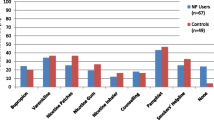Abstract
Pharmacotherapy substantially increases smoking cessation rates. However, programs to reduce barriers to this evidence-based treatment may not improve access among high risk immigrant non English speaking populations. This study estimates the effectiveness of a tailored free nicotine patch (NRT) program among Chinese American smokers living in New York City (NYC). Between July 2004 and May 2005 NRT was distributed to 375 smokers through two community-based organizations that serve the Asian American population in NYC. Participants completed an in person baseline survey and a 4-month follow-up telephone survey. Using an intention to treat analysis the abstinence rate at 4 months was 26.7% (100/375). Predictors of cessation included higher levels of self efficacy at baseline, not smoking while using the patch and concern about personal health risks. Distribution through easy to access, culturally competent local community organizations increased the reach of a free nicotine patch program and assisted smokers in quitting.
Similar content being viewed by others
References
Fiore M, Bailey W, Cohen S, et al. Treating tobacco use and dependence: clinical practice guideline. Rockville, MD: U. S. Department of Health and Human Services, US Public Health Service; 2000.
Centers for Disease Control and Prevention. Use of FDA-approved pharmacologic treatments for tobacco dependence—United States, 1984–1998. MMWR Morb Mortal Wkly Rep. 2000;49:665–668.
Bansal M, Cummings KM, Hyland A, Giovino G. Stop smoking medications: who uses them? Who misuses them? Who is misinformed? Nicotine Tob Res. 2004;6(Suppl 3):S303–10.
Miller N, Frieden TR, Liu SY, Matte TD, Mostashari F, Deitcher DR, et al. Effectiveness of a large-scale distribution programme of free nicotine patches: a prospective evaluation. Lancet. 2005;365(9474):1849–54.
Cummings KM, Hyland A, Fix B, Bauer U, Celestino P, Carlin-Menter S, et al. Free nicotine patch giveaway program 12-month follow-up of participants. Am J Prev Med. 2006;31(2):181–4.
Jolicoeur DG, Ahluwalia JS, Richter KP, Mosier M, Harris KJ, Gibson C, et al. The use of nicotine patches with minimal intervention. Prev Med. 2000;30(6):504–12.
An LC, Schillo BA, Kavanaugh AM, Lachter RB, Luxenberg MG, Wendling AH, et al. Increased reach and effectiveness of a statewide tobacco quitline after the addition of access to free nicotine replacement therapy. Tob Control. 2006;15(4):286–93.
Shelley D, Fahs M, Scheinmann R, Swain S, Qu J, Burton D. Acculturation and tobacco use among Chinese Americans. Am J Public Health. 2004;94(2):300–7.
Yu ES, Chen EH, Kim KK, Abdulrahim S. Smoking among Chinese Americans: behavior, knowledge, and beliefs. Am J Public Health. 2002;92(6):1007–12.
New York City Department of Health. www.nyc.gov/html/dcp/pdf/census/nyc20002.pdf.
Israel BA, Schulz AJ, Parker EA, Becker AB. Review of community-based research: assessing partnership approaches to improve public health. Annu Rev Public Health. 1998;19:173–202.
Schulz AJ, Parker EA, Israel BA, Becker AB, Maciak BJ, Hollis R. Conducting a participatory community-based survey for a community health intervention on Detroit’s east side. J Public Health Manag Pract. 1998;4(2):10–24.
Ajzen I. The theory of planned behavior. Organ Behav Hum Decis Process. 1991;50:79–211.
Hyland A, Borland R, Li Q, Yong H-H, McNeill A, Fong GT, et al. Individual level predictors of cessation behaviors among participants in the International Tobacco Control (ITC) Four Country Survey. Tob Control. 2006;15(Suppl III):iii83–iii94.
Shelley D, Nguyen N, Yerneni R, Fahs M. Tobacco use behaviors and household smoking bans among Chinese Americans. Am J Health Promot. 2008;22(3):168–75.
Farkas AJ, Pierce JP, Zhu SH, Rosbrook B, Gilpin EA, Berry C, et al. Addiction versus stages of change models in predicting smoking cessation. Addiction. 1996;91(9):1271–80.
New York City Housing and Vacancy Survey (NYCHVS) 1999. Housing and Household Economic Statistics Division. U.S. Census Bureau. 2000. http://www.census.gov/hhes/www/housing/nychvs/1999/nychvs99.html. Accessed 8 Aug 2007.
Jolicoeur DG, Richter KP, Ahluwalia JS, Mosier MC, Resnicow K. Smoking cessation, smoking reduction, and delayed quitting among smokers given nicotine patches and a self-help pamphlet. Subst Abus. 2003;24(2):101–106.
Cummings KM, Hyland A. Impact of nicotine replacement therapy on smoking behavior. Annu Rev Public Health. 2005;26:583–99.
Lai DW, Chau SB. Predictors of health service barriers for older Chinese immigrants in Canada. Health Soc Work. 2007;32(1):57–65.
Othieno J. Understanding how contextual realities affect African born immigrants and refugees living with HIV in accessing care in the Twin Cities. J Health Care Poor Underserved. 2007;18(3 Suppl):170–88.
Merzel C, D’Afflitti J. Reconsidering community-based health promotion: promise, performance, and potential. Am J Public Health. 2003;93(4):557–74.
Fisher E. The results of the COMMIT trial. Am J Public Health. 1995;85:159–60.
O’Loughlin J, Renaud L, Richard L, Gomez LS, Paradis G. Correlates of the sustainability of community-based heart health promotion interventions. Prev Med. 1998;27(5 Pt 1):702–12.
Pluye P, Potvin L, Denis JL, Pelletier J. Program sustainability: focus on organizational routines. Health Promot Int. 2004;19(4):489–500.
Manfredi C, Crittenden K, Cho YI, Engler J, Warnecke R. Maintenance of a smoking cessation program in public health clinics beyond the experimental evaluation period. Public Health Rep. 2002;116(Suppl 1):120–35.
Kim SS, Ziedonis D, Chen KW. Tobacco use and dependence in Asian Americans: a review of the literature. Nicotine Tob Res. 2007;9(2):169–84.
Acknowledgments
This study was funded by the Centers for Disease Control and Prevention (K01 DP000087-03). We thank Hsiao Liu for assistance in study implementation. This study was approved by the Columbia University Institutional Review Board.
Author information
Authors and Affiliations
Corresponding author
Rights and permissions
About this article
Cite this article
Shelley, D., Nguyen, N., Peng, CH. et al. Increasing Access to Evidence-Based Smoking Cessation Treatment: Effectiveness of a Free Nicotine Patch Program Among Chinese Immigrants. J Immigrant Minority Health 12, 198–205 (2010). https://doi.org/10.1007/s10903-008-9194-7
Received:
Accepted:
Published:
Issue Date:
DOI: https://doi.org/10.1007/s10903-008-9194-7




